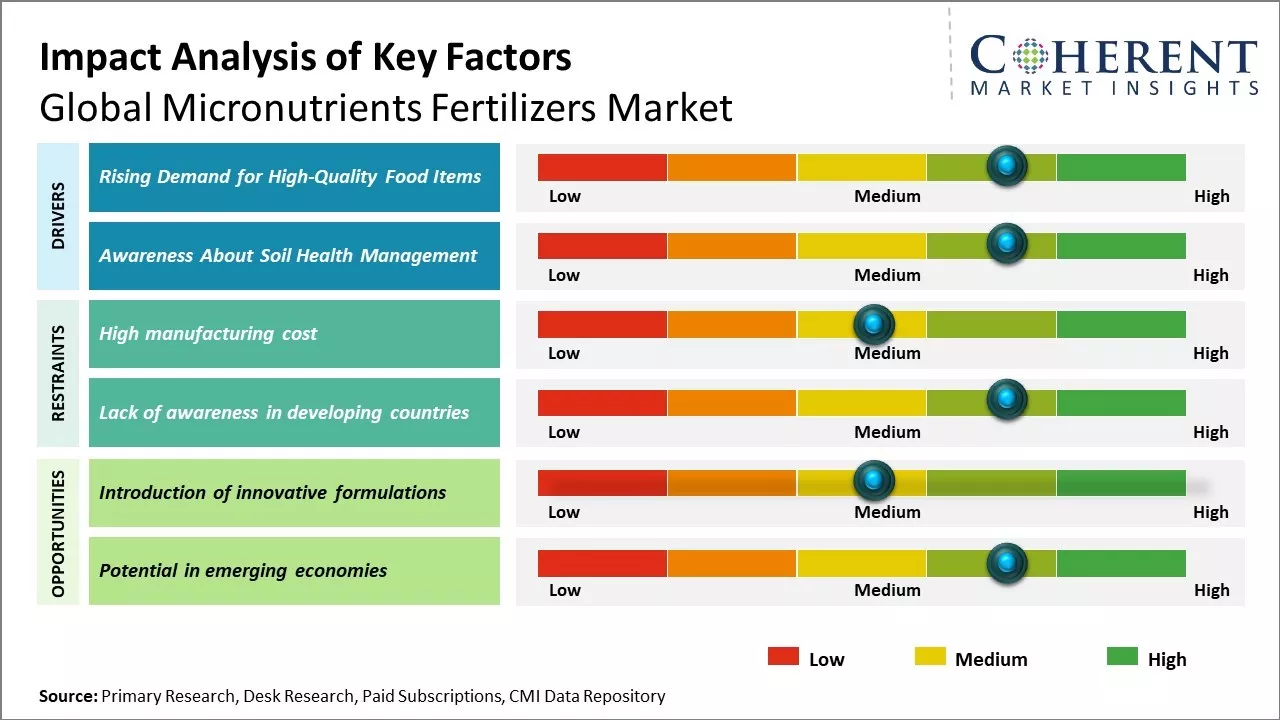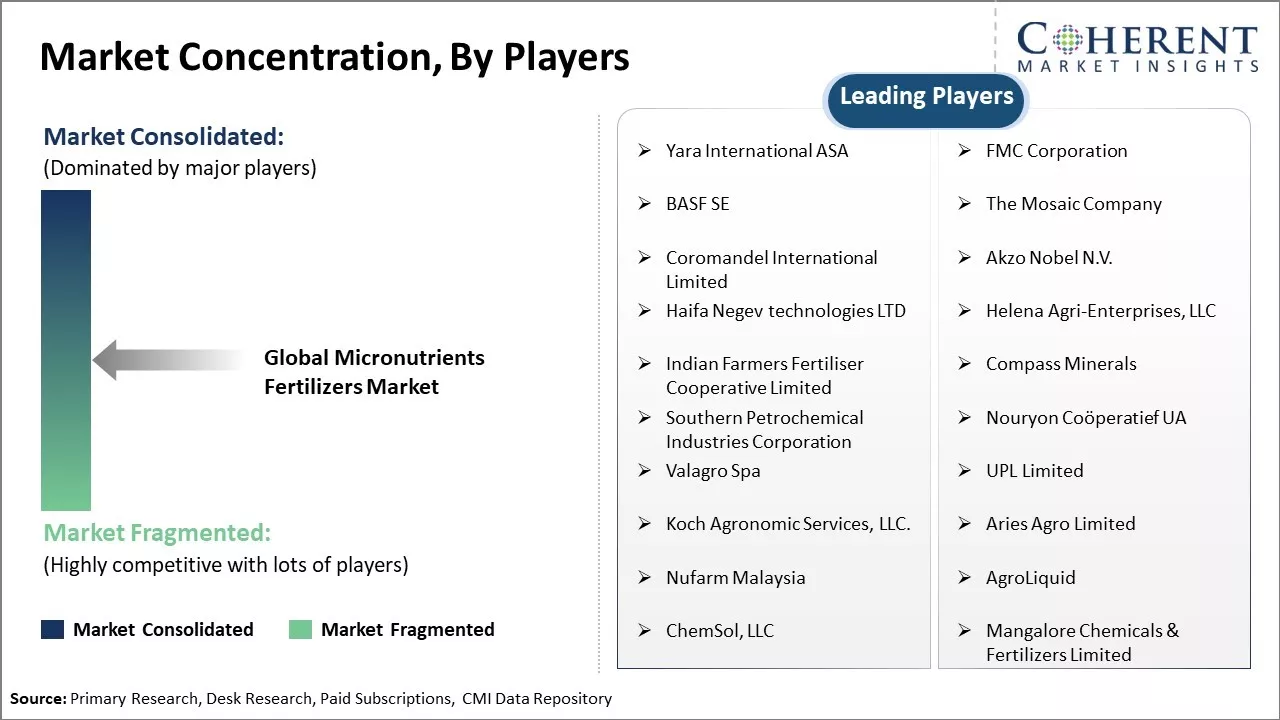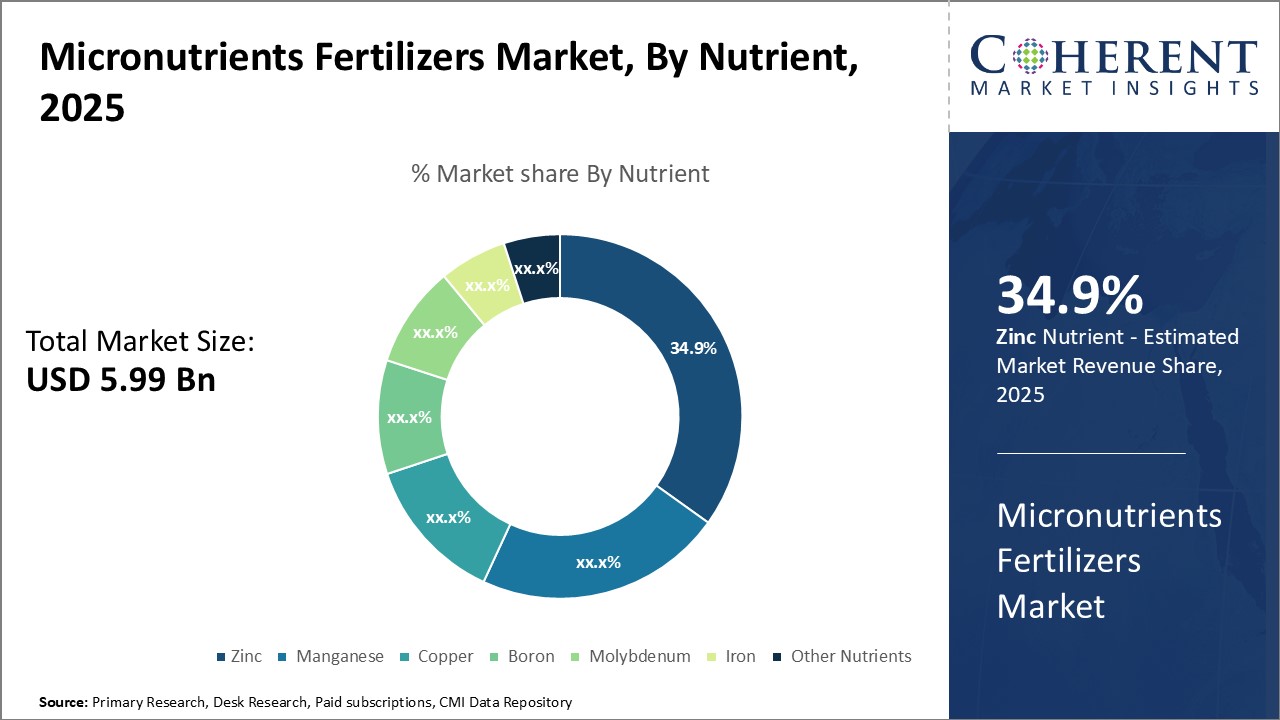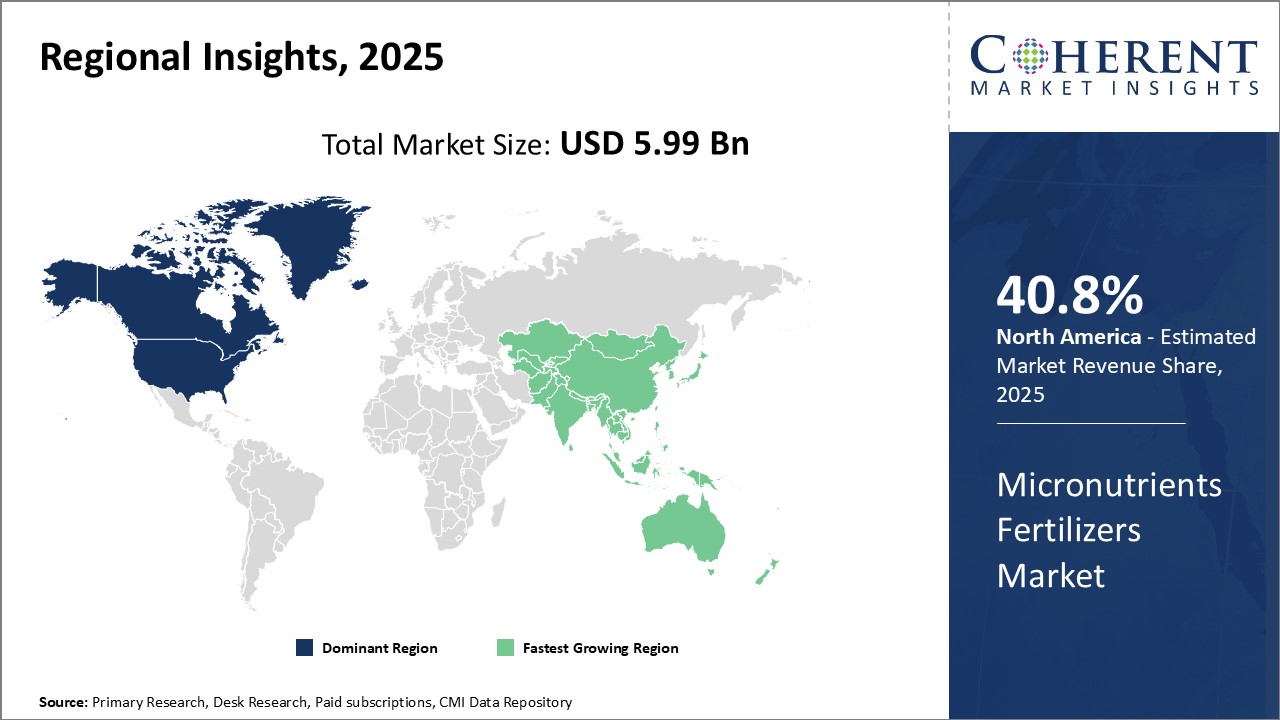The micronutrients fertilizers market is estimated to be valued at USD 5.99 Bn in 2025 and is expected to reach USD 9.56 Bn by 2032, exhibiting a compound annual growth rate (CAGR) of 6.9% from 2025 to 2032.

Discover market dynamics shaping the industry: Download Free Sample
Micronutrients such as zinc, boron, copper, chloride, manganese, molybdenum, and others are essential for plant growth and to boost crop yield which is driving the demand for micronutrient fertilizers. The micronutrients fertilizers market is expected to witness significant growth over the forecast period. The growth of the market is supported by the rising demand for food owing to continuously increasing population. Micronutrients play a vital role in improving the quality and quantity of agricultural production and maintaining overall soil health. Moreover, the increasing focus of farmers on sustainable agricultural practices and optimized usage of fertilizers is expected to boost the adoption of micronutrients fertilizers.
Rising Demand for High-quality Food Items
The demand for high-quality food items across the globe has increased tremendously over the past few decades. With rapid urbanization and improving economic conditions, people now have greater access to a variety of food options and their preferences for nutrition-rich foods has also increased. Most consumers today pay close attention to the ingredients and nutritional value of the food products they consume on a daily basis. This growing health-consciousness among individuals has propelled the demand for foods that are grown using balanced fertilizers which enrich the soil with essential micronutrients.
Micronutrient deficiencies in soil can severely impact the nutritional value and yield of crops. Farmers have recognized this challenge and are increasingly using micronutrients fertilizers to overcome micro-element deficiencies and improve crop health. Micronutrients such as iron, zinc, manganese, copper, etc. play a vital role in photosynthesis, enzyme activity and protein synthesis in plants. Their adequate presence in soil enables crops to maximize their growth potential and nutritional composition. As consumer preference for foods with high proteins, vitamins and minerals continues to rise, farmers are more motivated to adopt micronutrient fertilizers in order to grow crops that can fulfill these newest standards of nutrition. The food processing industry is also supportive of sourcing raw materials cultivated using balanced fertilization practices as it allows them to develop food products with optimum nutrient levels to cater to people's changing dietary requirements.

Get actionable strategies to beat competition: Download Free Sample
Awareness About Soil Health Management
There is growing widespread recognition of the importance of maintaining long-term soil fertility through balanced fertilization. Farmers around the world are increasingly realizing that excessive usage of nitrogen, phosphorus and potassium fertilizers can degrade the physical and biological properties of soil over time if micronutrients are not adequately supplemented. Continuous cropping and intensive farming without replacing the micronutrients removed from the soil eventually leads to deficiencies. This not only impacts crop yields but also makes soils more vulnerable to diseases and environmental stresses. Inadequate presence of micronutrients like zinc, boron, and manganese also affects the quality of agricultural produce.
Various initiatives by government extension services and agricultural universities are educating farmers about the significance of micronutrient management. They are spreading awareness about soil test-based fertilization practices and how balanced supplementation of macronutrients and micronutrients contributes to overall soil health.
Key Takeaways from Analyst:
The major driver for the growth is the rising awareness about the deficiency of micronutrients in soil globally. Farmers are recognizing the importance of complete nutrient supplementation of micronutrients such as iron, zinc, manganese, copper, and boron along with macronutrients. This is positively impacting the demand for micronutrients fertilizers. Another factor propelling the market growth is the ban on pesticides and chemicals by various regulatory bodies which is increasing organic and sustainable agricultural practices.
The market may face restraints from the higher costs of micronutrients fertilizers as compared to conventional fertilizers. The price sensitive nature of agricultural industry can hamper the mass adoption of these fertilizers.
Additionally, lack of education among smaller farmers regarding consequences of micronutrient deficiencies can deter the market to some extent.
Market Challenges: High manufacturing cost
The high manufacturing costs involved in micronutrients fertilizers production is one of the major challenges restraining the growth of the global micronutrients fertilizers market. Micronutrients fertilizers contain vital nutrients like zinc, manganese, iron, boron, chloride and molybdenum that are required by plants in very small quantities. However, producing fertilizers with precise amounts of these micronutrients adds significantly to the production costs.
Adding micronutrients into fertilizers individually and maintaining their stability through the supply chain is a complex process which involves advanced manufacturing techniques. Producing micronutrients separately in the form of sulphates, oxides or chelates and then mixing them uniformly with other macronutrients like nitrogen, phosphorus and potassium require high technical skills and quality control measures. This makes the manufacturing of micronutrients fertilizers a capital intensive and technology-oriented process. The R&D expenditures towards developing new formulations and efficient application methods further contribute to high manufacturing costs.
Market Opportunities: Introduction of innovative formulations
The introduction of innovative formulations could provide significant opportunities for growth in the global micronutrients fertilizers market. Micronutrients play an important role in improving soil health and yield while supporting sustainable agriculture. However, traditional fertilizer formulations have poor solubility and dispersion issues that limit their uptake and effectiveness for crops. New technologies that allow for micronutrients to be efficiently delivered to plants could help address nutrient deficiencies more comprehensively.
Tailoring formulations based on soil type and crop needs would enhance the efficiency of micronutrient delivery. For instance, the combination of sulfur and zinc in a single granule enables synchronous supply to soil. This duo formulation improves both nutrients' solubility for greater assimilation by plants. Similarly, adding micronutrients to nitrogen fertilizers helps package them for simultaneous soil application and absorption by roots. The development of slow- and controlled-release formulations could also ensure micronutrients remain available to plants for extended periods, thereby boosting absorption compared to traditional quick-release fertilizers. Such tailored smart formulations provide targeted nutrition and maximize crop yields.

Discover high revenue pocket segments and roadmap to it: Download Free Sample
Insights by Nutrient: Micronutrients play a vital role in plant health and growth
In terms of nutrient, zinc is expected to contribute 34.9% share of the market in 2025, owing to widespread zinc deficiency across major agricultural regions. As a micronutrient, zinc plays a key role in various metabolic functions of plants including protein synthesis, photosynthesis, and carbohydrate metabolism. Lack of adequate zinc uptake from soil often leads to retarded plant growth and reduced crop yields. Farmers extensively use zinc-based fertilizers to prevent zinc deficiency in crops and maximize productivity. Cereals and grains which are the most widely cultivated food crops face widespread zinc deficiency issues. This drives significant demand for zinc-containing fertilizers globally.
Insights by Form: Chelated form provides superior nutrient availability
Among the form, chelated is expected to contribute 66% of the market share in 2025, owing to its stronger agronomic characteristics. Chelated micronutrients form stable soluble complexes that remain available for plant uptake even in soils with high pH or presence of other competing elements. This ensures consistent and reliable supply of micronutrients to crops regardless of soil conditions. Non-chelated forms are prone to precipitation or immobilization in soil making the nutrients unavailable to plants. Farmers prefer chelated variants as they deliver better returns on investment through guaranteed crop performance. Manufacturers also focus on expanding chelated micronutrient lines to capitalize on the growth opportunities in this superior performing segment.
Insights by Crop Type: Fruit and vegetable sector demands balanced micronutrient support
In terms of crop type, the fruits and vegetables segment is expected to contribute 37.2% of the market share in 2025, owing to intensive micronutrient requirements of horticultural crops. Fast growing produce like fruits and vegetables require balanced supply of various micronutrients during the crop growth cycle. Even minor micronutrient deficiencies can compromise the yield, quality and shelf-life of fruits and vegetables. This makes micronutrient management through specialized fertilizer blends critical. Developing technologies like fertigation further facilitate controlled delivery of micronutrients according to the specialized needs of different fruits and vegetable varieties. These factors drive strong demand from the high-value horticulture segment.

Need a Different Region or Segment? Download Free Sample
North America has established itself as the dominant region in the micronutrients fertilizers market. The region is expected to account for 40.8% of the market share in 2025. The large-scale presence of agrochemical companies along with the widespread adoption of modern agricultural practices has propelled the region to the leading position. The U.S. accounts for the major share of the North American market owing to its huge agricultural output. Leading fertilizer producers have set up manufacturing facilities across major farming states like Iowa, Illinois, Nebraska, and Minnesota in the U.S. to effectively cater to local demand. Furthermore, strong distribution networks of key players ensure timely availability of micronutrients fertilizers for farmers. The region also has a robust regulatory framework regarding fertilizer quality and application methods, promoting safe usage.
Asia Pacific is poised to emerge as the fastest growing regional market for micronutrients fertilizers over the next five years. Countries like India, China, Indonesia, and Vietnam showcase immense scope for market expansion supported by their sizable farmlands and increasing crop yields. Rising disposable incomes and growing population has intensified the need for sustained food production in these nations. Additionally, favorable government initiatives are emphasizing the use of micro-nutrients in the regional soil to enhance crop health and combat deficiencies naturally. China especially stands to gain considerably given its position as the largest producer and consumer of fertilizers globally. The low cost of production and presence of international fertilizer manufacturers also provide impetus to market penetration in Asia Pacific.
Micronutrients Fertilizers Market Report Coverage
| Report Coverage | Details | ||
|---|---|---|---|
| Base Year: | 2024 | Market Size in 2025: | USD 5.99 Bn |
| Historical Data for: | 2020 To 2024 | Forecast Period: | 2025 To 2032 |
| Forecast Period 2025 to 2032 CAGR: | 6.9% | 2032 Value Projection: | USD 9.56 Bn |
| Geographies covered: |
|
||
| Segments covered: |
|
||
| Companies covered: |
Yara International ASA, FMC Corporation, BASF SE, The Mosaic Company, Coromandel International Limited, Akzo Nobel N.V., Haifa Negev technologies LTD, Helena Agri-Enterprises, LLC, Indian Farmers Fertiliser Cooperative Limited, Compass Minerals, Southern Petrochemical Industries Corporation, Nouryon Coöperatief UA, Valagro Spa, UPL Limited, Koch Agronomic Services, LLC., Aries Agro Limited, Nufarm Malaysia, AgroLiquid, ChemSol, LLC, and Mangalore Chemicals & Fertilizers Limited |
||
| Growth Drivers: |
|
||
| Restraints & Challenges: |
|
||
Uncover macros and micros vetted on 75+ parameters: Get instant access to report
*Definition: The micronutrients fertilizers market consists of fertilizer products that supply plants with essential micronutrients which are needed in small quantities for proper growth. This includes fertilizers that provide micronutrients like iron, manganese, zinc, boron, copper, and molybdenum. Micronutrient fertilizers help overcome deficiencies in soil and promote optimal plant nutrition, yield, and quality.
Share
Share
About Author
Yash Doshi is a Senior Management Consultant. He has 12+ years of experience in conducting research and handling consulting projects across verticals in APAC, EMEA, and the Americas.
He brings strong acumen in helping chemical companies navigate complex challenges and identify growth opportunities. He has deep expertise across the chemicals value chain, including commodity, specialty and fine chemicals, plastics and polymers, and petrochemicals. Yash is a sought-after speaker at industry conferences and contributes to various publications on topics related commodity, specialty and fine chemicals, plastics and polymers, and petrochemicals.
Missing comfort of reading report in your local language? Find your preferred language :
Transform your Strategy with Exclusive Trending Reports :
Frequently Asked Questions
Joining thousands of companies around the world committed to making the Excellent Business Solutions.
View All Our Clients